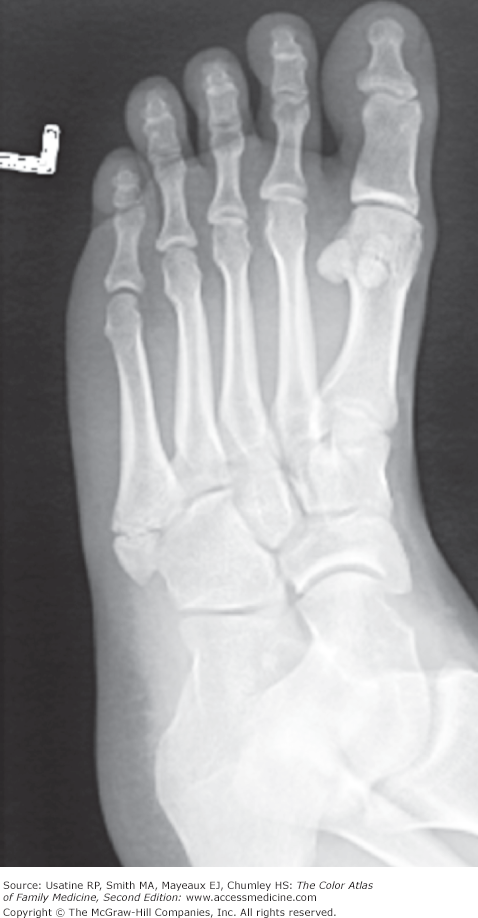Patient Story
A 37-year-old man inverted his ankle while playing basketball with his teenagers in their driveway. He felt a pop and had immediate pain. He had tenderness over the base of his fifth metatarsal. Having met the Ottawa ankle rules for radiographs (see later), a radiograph was obtained, which revealed a nondisplaced fracture at the base of the fifth metatarsal (Figure 104-1).
Introduction
Most metatarsal fractures involve the fifth metatarsal and include avulsion fractures at the base, acute diaphyseal fractures (Jones fracture), and diaphyseal stress fractures. Fractures of the first through fourth metatarsals are less common but can be associated with a Lisfranc injury. Diagnosis is based on the mechanism of injury or type of overuse activity and radiographic appearance. Treatment depends on the type of fracture. Most metatarsal fractures have a good prognosis; however, Jones fractures have a high rate of nonunion and Lisfranc injuries can result in chronic symptoms.
Synonyms
Epidemiology
- Foot fractures are common injuries among recreational and serious athletes; however, incidence and prevalence in most populations is unknown.
- In women older than age 70 years, the incidence of foot fractures is 3.1 per 1000 woman-years, and more than 50% of these are fifth metatarsal fractures.1
- Fifty percent of metatarsal fractures in adults ages 16 to 75 years involve the fifth metatarsal.2
- The majority of fifth metatarsal fractures are avulsion injuries (Figure 104-1).
- Twenty-three percent of elite military personnel sustain metatarsal stress fracture; most of these occur after 6 months of training.3
Etiology and Pathophysiology
- Avulsion fractures result when the peroneus brevis tendon and the lateral plantar fascia pull off the base of the fifth metatarsal, typically during an inversion injury while the foot is in plantar flexion.
- Jones (acute diaphyseal) fracture results from landing on the outside of the foot with the foot plantar flexed.
- Diaphyseal stress fractures are caused by chronic stress from activities such as jumping and marching.
- Fractures of the first through fourth metatarsals are caused by direct blows or falling forward over a plantar-flexed foot. These fractures may be associated with a Lisfranc injury.
Diagnosis
The diagnosis of avulsion or Jones fractures is made on plain radiographs in a patient with a history of injury and acute lateral foot pain. Diaphyseal stress fractures may require CT imaging.
- Avulsion injury—Sudden onset of pain (and tenderness on examination) at the base of the fifth metatarsal after forced inversion with the foot and ankle in plantar flexion.
- Acute Jones fracture—Sudden pain at the base of the fifth metatarsal, with difficulty bearing weight on the foot, after a laterally directed force on the forefoot during plantar flexion of the ankle.
- Stress fracture—History of chronic foot pain with repetitive motion.
- Avulsion fracture—Fracture line at base of fifth metatarsal oriented perpendicularly to the metatarsal shaft (Figure 104-1). May extend into joint with cuboid bone, but does not extend into the intermetatarsal joint.
- Acute Jones fractures (Figure 104-2

Stay updated, free articles. Join our Telegram channel

Full access? Get Clinical Tree



